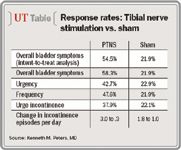Article
Long-term OAB can be positively affected by tibial nerve stimulation
Evidence that percutaneous tibial nerve stimulation is an effective, drug-free treatment for overactive bladder is mounting. A double-blind, sham-controlled, multicenter trial showed a response rate of about 50% in patients who have struggled with symptoms for a decade.

Key Points
St. Petersburg, FL-Evidence that percutaneous tibial nerve stimulation (PTNS) is an effective, drug-free treatment for overactive bladder is mounting. A double-blind, sham-controlled, multicenter trial showed a response rate of about 50% in patients who have struggled with symptoms for a decade.

In the trial, dubbed SUmiT (Study of Urgent PC vs. Sham Effectiveness in Treatment of Overactive Bladder Symptoms), 220 patients were randomized to active or sham treatment. Draping prevented them from seeing whether they were receiving PTNS (Urgent PC system, Uroplasty, Minnetonka, MN) or sham. For the latter, technicians used a Streitberger needle (which delivers a prick sensation but collapses without penetrating the skin) to give patients the impression of having the needle inserted, and delivered low current from a transcutaneous electrical nerve stimulation unit to the foot to give patients some sensation. The coordinator did not know which treatment each patient received.

After a 2-week washout period when they took no antimuscarinics, patients received 12 weekly, 30-minute therapy sessions. They rated their overall response, completed voiding diaries, and answered the OAB-q and short-form health survey (SF-36) questionnaires. Patients were considered responders if they rated their symptoms as moderately or markedly improved.
High response rate
Of the 220 patients, 208 completed the study-103 receiving active treatment and 105 the sham treatment. The intent-to-treat analysis (with dropouts considered nonresponders) yielded a response rate of 54.5% in the active treatment group, compared with 21.9% among the sham-treatment group for overall bladder symptoms, a significant difference.
Based on patients completing the 12 weeks of follow-up, the response for overall bladder symptoms was also significantly better-54.5% for PTNS compared with 20.9% for sham treatment. In addition, the differences in response for urgency, frequency, and urge incontinence were all significant as well-42.7% versus 22.9%, 47.6% versus 21.9%, and 37.9% versus 22.1%, respectively.
Voiding diaries showed significant differences, too, with PTNS patients' voids dropping from 12.3 to 9.8 per day, compared with sham-treatment patients' voids, which remained essentially unchanged at 11.0 per day compared with 12.4 per day at the start. Daily episodes of urge incontinence dropped significantly from 3.0 to 0.3 for PTNS patients, compared with 1.8 to 1.0 for sham-treatment patients.
The OAB-q scores showed statistically significant improvements in symptom severity and health-related quality of life for the PTNS patients compared with sham-treated patients. Although there were no statistically significant differences between the groups in overall scores on the SF-36, improvements were significantly better in the physical and mental scales for the PTNS patients.





